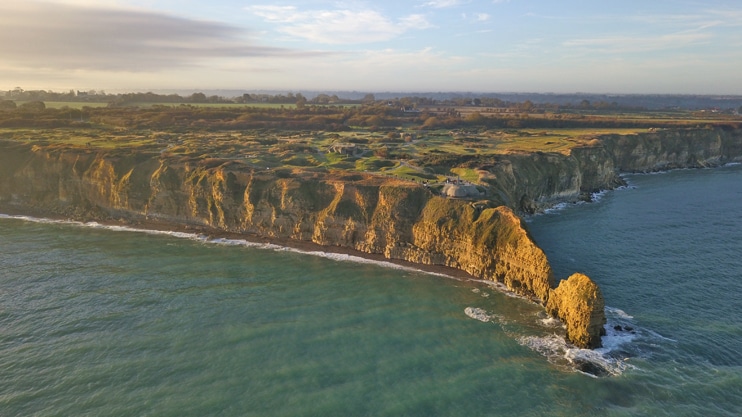In the early hours of June 6, 1944, when darkness still prevailed, 225 American rangers set off in the direction of Pointe du Hoc, a rocky spur rising 30 meters above the ground. This special operation, designed to neutralize the heavy German artillery stationed at its summit, proved crucial to the success of Operation Overlord. The operation, due to begin a few hours later, will be remembered as the day of the Normandy landings.
Considered the most dangerous fortification in the American assault zone at the time of the D Day, the Pointe du Hoc (Cricqueville-en-Bessin) was undoubtedly one of the most strategic locations in the Atlantic Wall erected by the German army.
The mission of Lieutenant-Colonel James Earl Rudder and his 225 rangers was to annihilate the 155 mm cannons capable of pointing at two of the five beaches chosen for the Allied landings (Omaha Beach to the east and Utah Beach to the west). These American soldiers of the 2nd Ranger Battalion, armed with grappling hooks and other weapons, were ordered to climb the cliffs once the US Navy had finished shelling the coast. They were to sabotage heavily protected German installations… but all did not go according to plan!
Wall of rock, barbed wire and concrete
In February 1944, German forces set up an impressive defensive garrison not far from Harfleur, on Pointe du Hoc. The name alone evokes the difficulty of the mission entrusted to Lieutenant-Colonel James E. Rudder. “Hoc” comes from ‘haugr’ in Norois, the language of the Vikings, and means mound. This toponymy is common in the Norman language, and can be found in places like Saint Vaast La Hougue, but it’s an understatement when you consider the topography of the site. In fact, this concrete fortress, bordering the coastline, sits on a plateau which itself ends abruptly in rocky cliffs 25 to 30 metres high, constituting as many natural walls.
In addition to bunkers with 2-meter-thick walls and ceilings linked by an underground network and a telegraph center, the defense system includes six French-made 155 mm howitzers dating from the First World War. These were placed in open-air recesses.
Following Rommel’s inspection in January 1944 to reinforce German defences along the Atlantic Wall, concrete shelters were planned to protect the guns. Fortunately for the Allies, by spring only two casemates were operational, and four were still under construction.
The gunners stationed at this strategic site belonged to the 2nd battery of the Heeres-Küsten-Artillerie-Abteilung 1260, and were initially commanded by Oberleutnant Frido Ebeling. After refusing to open fire on a British naval patrol in October 1943, he was replaced by his deputy, Oberleutnant Brotkorb.
These men were supported by infantrymen from the 3rd Battalion of Grenadier-Regiment 726, responsible for protecting the coastline between Grandcamp-les-Bains and Vierville-sur-Mer. Since May, they have been joined by fifteen artillerymen from the Werfer-Regiment and 84 machine-gunners.
Suicide operation?
Thanks to its dominant position, the German artillery battery at Pointe du Hoc was able to fire all the way to Omaha Beach, 6 km away… The Allies therefore decided, in addition to the air and naval bombardments, to set up an assault troop to destroy the gun battery and secure the Omaha Beach perimeter in order to limit the loss of life.
On the morning of June 6, at around 4:30 a.m., an amphibious operation was launched: 10 assault barges, accompanied by 2 equipment barges and 4 amphibious trucks set off towards Pointe du Hoc. On board were the 225 Rangers of the 2nd Ranger Battalion, under the command of Lieutenant-Colonel James Earl Rudder, a former Texas farmer.
As specified in the full operation order of March 26, 1944, signed by Major General Gerow, commanding the V Corps, his men’s mission was to “destroy the coastal defenses of Pointe du Hoe (sic) and Pointe de la Percée, and flank the assault at Omaha. Supported by landed elements, seize the Grandcamp and Maisy batteries. Then operate against enemy positions along the coast between Grandcamp and Isigny“.
At 6:30 a.m., the uninterrupted shelling of coastal positions by the battleship USS Texas ceased: it was time for Lieutenant-Colonel Rudder’s men to go into action. However, a navigational error, due in part to strong sea currents, delayed the operation by almost 40 minutes. This unexpected reprieve allowed the German army to reorganize.
Despite two landing barges sunk by the enemy, it was 7.10 a.m. when the Rangers of the 2nd Ranger Battalion disembarked and set off to attack the eastern flank of Pointe du Hoc. Using rocket launchers propelling grappling hooks attached to knotted ropes, ladders and even their own daggers, the Rangers set off on their perilous ascent under heavy enemy fire. Their climb was covered by fire from the destroyer USS Satterlee.
Although the defensive site was finally taken in a fierce battle, it was too late to hope for reinforcements from the 500-strong 5th Ranger Battalion, waiting offshore aboard the USS Satterlee.
Having failed to see the signal at 7 a.m. sharp, as originally planned, they were landed directly on Omaha Beach.
Subterfuge
By 7:40 a.m., most of Colonel Rudder’s Rangers had climbed to the summit.
They discovered that the stronghold had no cannons, either in the casemates or in the concrete tanks. Instead, there were decoys, and what decoys they were: large wooden planks covered with netting, the better to fool the Allied air force.
At 9.30am, the assault troops discovered the real guns pointing towards Utah Beach and destroyed them. The guns had been moved to the south of the site, 1 km inland along a small hedge-lined path. This maneuver was intended to protect the artillery pieces from the Allied bombardment raging two months earlier.
Isolated on the Pointe, the soldiers of the 2nd Ranger Battalion endured two days of German counter-attacks.
On the morning of June 8, Lieutenant-Colonel Max F. Schneider’s 5th Ranger Battalion and the 29th DIUS finally came to the aid of the 90 Rangers entrenched on Pointe du Hoc. The Battle of Normandy began, paving the way for the liberation of Paris on August 25, 1944.
The courage of these men enabled some 133,000 men to land at midnight on June 6, 1944: the Americans on Omaha Beach and Utah Beach, the British on Gold Beach and Sword Beach, and the Canadians on Juno Beach. That D Day, 10,500 Allied soldiers were killed, wounded, missing or taken prisoner, including 6,000 Americans. Casualties amounted to 2,500 men on Omaha Beach alone, and 197 on Utah Beach.
For the ceremonies commemorating the 80th anniversary of D-Day, other memorial sites have been chosen: the American military cemetery at Colleville-sur-mer, the British memorial at Ver-sur-mer, and the Juno Beach center (now Courseulles-sur-Mer). The international ceremony, attended by 25 heads of government, including President Emmanuel Macron, King Charles III, Canadian Prime Minister Justin Trudeau, US President Joe Biden and Ukrainian President Volodymyr Zelensky, will take place on Omaha Beach (now Saint-Laurent-sur-mer).
Read also > Ahead of the G7 Summit in June: Ukraine at the center of discussions, Russia and China in the background
Featured Photo: Hubert Groult/Pointe du Hoc














